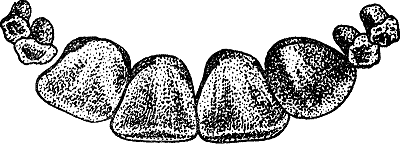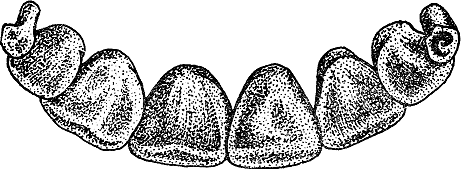DETERMINING THE AGE OF CATTLE
BY THE TEETH
GEORGE W. POPE
Quarantine Division

FARMERS' BULLETIN 1066
UNITED STATES DEPARTMENT OF AGRICULTURE
Contribution from the Bureau of Animal Industry
JOHN R. MOHLER, Chief
Washington, D. C.August, 1919
Division of Publications, United States Department of Agriculture
PUBLICATIONS OF U. S. DEPARTMENT OF AGRICULTURERELATING TO CATTLE.
AVAILABLE FOR FREE DISTRIBUTION BY THE DEPARTMENT.
Vesicular Stomatitis of Horses and Cattle. (Department Bulletin 662.)
Hemorrhagic Septicemia. (Department Bulletin 674.)
Breeds of Beef Cattle. (Farmers' Bulletin 612.)
The Feeding of Dairy Cows. (Farmers' Bulletin 743.)
Feeding and Management of Dairy Calves and Young Dairy Stock. (Farmers'Bulletin 777.)
Contagious Abortion of Cattle. (Farmers' Bulletin 790.)
Breeds of Dairy Cattle. (Farmers' Bulletin 893.)
Dehorning and Castrating Cattle. (Farmers' Bulletin 949.)
Cattle Scab. (Farmers' Bulletin 1017.)
DETERMINING THE AGE OF CATTLEBY THE TEETH.
The age of cattle can be approximated closely by theappearance, development, and subsequent wear of their secondincisor teeth. Cattle have eight incisor teeth, all in the lower jaw.In the calf at birth two or more of the temporary or first incisor teethare present. With the first month the entire eight incisors have appeared.
 Fig. 1.—Internal face of incisors of the calf.
Fig. 1.—Internal face of incisors of the calf.As the animal approaches 2 years of age the center pair of temporaryincisor teeth or pinchers are replaced by the permanent pincherswhich at 2 years attain full development.
 Fig. 2.—Internal face of incisors at 2 years.
Fig. 2.—Internal face of incisors at 2 years.At from 2½ to 3 years the permanent first intermediates are cutand are usually fully developed at 3 years.
 Fig. 3.—Internal face of incisors at 3 years.
Fig. 3.—Internal face of incisors at 3 years.[4]At 3½ years the second intermediates or laterals are cut. They areon a level with the first intermediates and begin to wear at 4 years.
 Fig. 4.—Internal face of incisors at 4 years.
Fig. 4.—Internal face of incisors at 4 years.At 4½ to 5 years the corner teeth are replaced, the animal at 5years having the full complement of incisors with the corners full